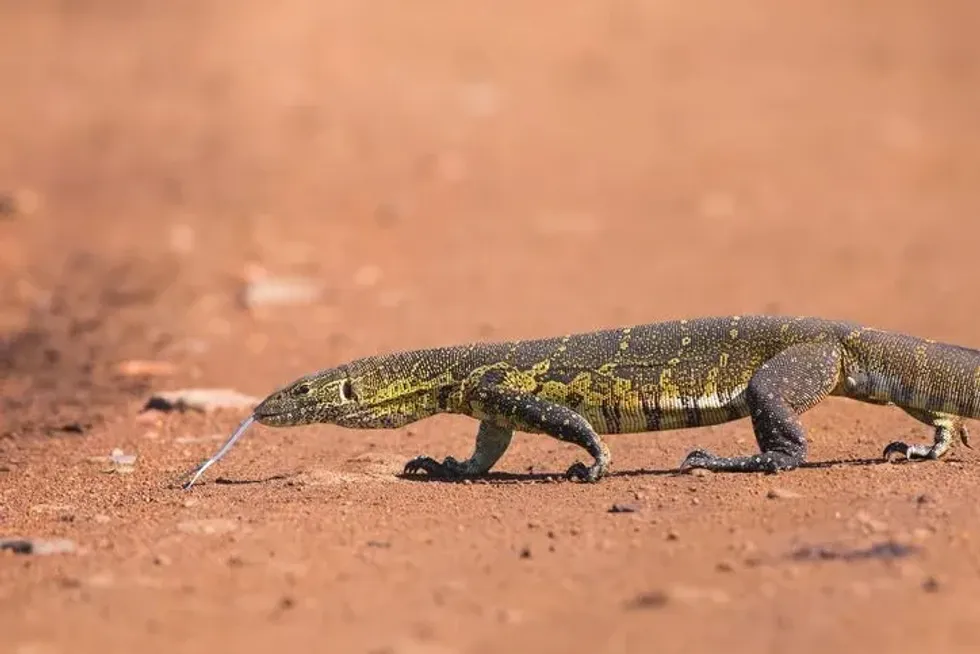The Nile monitor (Varanus niloticus) is a species of semi-aquatic monitor lizard native to the regions of Sub-Saharan Africa along the river Nile. The Nile monitor lizards go by several other names, such as the water leguaan, river leguaan, guana, and the African small-grain lizard.
This species of monitor lizards are different from the population of monitor lizards found in the forests and savannahs of West Africa, and that goes by the name of West African Nile monitor (Varanus stellatus).
The Nile monitor lizards belong to the Varanidae family of monitors and are characterized by well-developed limbs, powerful claws and tails, and long necks. With body color that ranges from olive green to black with yellowish or cream-colored stripes and spots on the head and the limbs, the Nile monitor is covered in tough scales, typical of the reptiles.
The tail of the Nile monitor is longer than their bodies, and these carnivorous animals are even known for their ability to outrun humans in short distances!
Find the Nile monitor interesting? Here's a lot more you can learn about this amazing reptile!If you like reading this content, you may also enjoy reading fun facts about olive ridley sea turtle and Aldabra giant tortoise.
Nile Monitor Interesting Facts
What type of animal is a Nile monitor?
The Nile monitor (Varanus niloticus) is a species of monitor lizard.
What class of animal does a Nile monitor belong to?
The Nile monitors belong to the class Reptilia, meaning they are reptiles.
How many Nile monitors are there in the world?
There are more than 70 extant species of monitor lizards in the world, and the Nile monitors are one of them. At present, there is no data on the exact number of these reptiles in the world.
Where does a Nile monitor live?
Nile monitors live in a range of different habitats, including woodlands, scrub forests, dry savannahs, swamps, evergreen thickets, and mangroves. Being semi-aquatic, they prefer habitats with a source of water such as rivers and lakes.
What is a Nile monitor's habitat?
The Nile monitor's geographical distribution spreads throughout large swathes of areas in sub-Saharan Africa and along the river Nile, up to Egypt. However, they are not native to dry desert areas such as the Kalahari Desert, Sahara Desert, and most of the Horn of Africa.
Since these reptiles are mostly active during the day and spend much time basking in the sun, an open habitat is crucial for them. The Nile monitors dwell in burrows which they build themselves.
The burrows are usually made out of soft and sandy soil. Nile monitors that lie in the colder regions of South Africa hibernate in burrows and cracks of huge rocks.
Who do Nile monitors live with?
The Nile monitor is a solitary animal, except during the mating season. They rarely interact with their own kind outside of the breeding season.
How long does a Nile monitor live?
The Nile monitor's lifespan is estimated to be of 10 years in the wild and about 15 years in captivity.
How do they reproduce?
Both male and female Nile monitors have several mating partners. Reproduction is annual affair, and occurs once a year in the span of June-October. However, it is only after the rainy season that mating and egg-laying happens, but this too is subject to regional weather variations.
The spring rains of August through September are followed by the Nile monitor females laying 12-60 eggs in active termite nests or holes dug in the ground. The larger the female, the more eggs she will lay.
The holes or termite nests provide a secure place for the incubation of the eggs, which may take up to one year to hatch.
After the young emerge from the eggs, the females either return to the clutch to free the young from the buried nest, or the young wait for the rains to soften the hard nest. About 35 offsprings are born at a time by the hatching of eggs.
Nile monitor care by the parents is not well-developed, and once the hatchlings emerge, they are left to fend for themselves.
What is their conservation status?
Nile monitors are given the status of Least Concern by the International Union for Conservation of Nature (IUCN) Red List of Threatened Species. While their exact numbers are not known, the IUCN believes, based on their sightings, that this monitor's population is not currently under threat.
Nile Monitor Fun Facts
What do Nile monitors look like?

Nile monitor lizards are olive green, greenish-gray, or brownish in color with dark reticulation. Besides, these reptiles are characterized by yellowish, V-shaped stripes starting from the base of the head and skull that progressively become bands and spots on the limbs and along the back.
The head is dotted with yellowish-green spots. The underside of the body is yellowish with dark-colored cross bands.
The tail is longer than their body, laterally compressed, and lightly banded. The monitor lizard has a strong physique with tough and scaly skin. The long tail, coupled with exceptionally powerful legs and claws, makes this lizard an excellent climber and swimmer. Nile monitor teeth are adapted for crushing the hard shells of prey.
How cute are they?
Nile monitor lizards are not particularly cute, but neither do they look very threatening.
How do they communicate?
Nile monitors have good eyesight and perceive their environment through their olfactory and visual senses. These reptiles can also sense their surroundings through auditory, tactile, and chemical stimuli. If cornered or threatened, Nile monitors tend to raise themselves, inflate their throats, and scare the attacker by lashing their tail, accompanied by a loud hissing.
How big is a Nile monitor?
A full-grown Nile monitor size ranges between 3.9-7.2 ft (119-219.4 cm) in length. The size of the largest Nile monitor is almost the same as that of an adult Komodo dragon.
How fast can a Nile monitor run?
Nile monitors can run on land with a speed of up to 18 mph (29 kph).
How much does a Nile monitor weigh?
Variations exist regarding the weight of the Nile monitor. Full-grown individuals weigh about 15 lb (6.8 kg) on average.
What are their male and female names of the species?
Male and female Nile monitors do not have any distinct names.
What would you call a baby Nile monitor?
Baby Nile monitors are referred to as hatchlings.
What do they eat?
The Nile monitor species of lizards are carnivorous that prey on a wide variety of animals. Their diet includes toads, frogs, fish, rodents, lizards, birds, small turtles, crabs, beetles, spiders, caterpillars, earthworms, millipedes, small mammals, and slugs. The Nile monitor diet is incomplete without hard-shelled mollusks. A Nile monitor eating crocodiles' eggs is not uncommon, either.
Are they dangerous?
Nile monitors tend to stay away from humans and do not attack unless provoked or threatened. Adult Nile monitors are capable of inflicting wounds through biting and scratching.
Would they make a good pet?
A Nile water monitor is too aggressive to be kept as a pet, and it can be quite challenging to have a Nile monitor pet in captivity. Still, they are frequently found in the pet trade.
A Nile monitor lizard pet would require a large Nile monitor cage or enclosure that is at least 12 ft (3.6m) long and secure enough to prevent the animal from escaping. The terrarium or enclosure should be temperature-controlled, must have a water source, and something for the lizard to hide in and climb on.
Besides, Nile monitor feeding and diet incurs a lot of costs. However, a tame Nile monitor is quite rare. The savannah monitor lizard species are comparatively more docile pets.
Did you know...
Nile monitors are a common invasive species in Florida, USA.
Compared to a black Nile monitor, an albino Nile monitor (leucistic Nile monitor) has a pale body color.
Since the Nile monitor population has its native range in Africa, they require a basking temperature of 120 degrees Fahrenheit (49 degrees Celsius) when kept in an enclosure. Wild populations of Nile monitors undergo steady growth and mature at 3-4 years of age.
Nile monitors can hold their breath underwater for almost an hour.
A Nile monitor bite can be crushingly painful and is capable of killing small-sized prey. When an aggressive or cornered Nile monitor bites, it emits a foul-smelling substance from its cloaca to fend off the attacker.
Like most other monitors, the Nile monitor can suffer from respiratory infections if it gets too cold or is kept in a cold and damp environment.
Where are Nile monitors often seen?
Since they feed on crocodile eggs, Nile monitors are often seen near nesting sites of crocodiles.
What extinct animal is the Nile monitor closely related to?
The Nile monitor is closely related to the mosasaur. This was a large sea monster that existed 65 million years ago and is now extinct.
Here at Kidadl, we have carefully created lots of interesting family-friendly animal facts for everyone to discover! Learn more about some other reptiles including green anaconda, or smooth green snake.
You can even occupy yourself at home by drawing one on our Nile monitor coloring pages.










